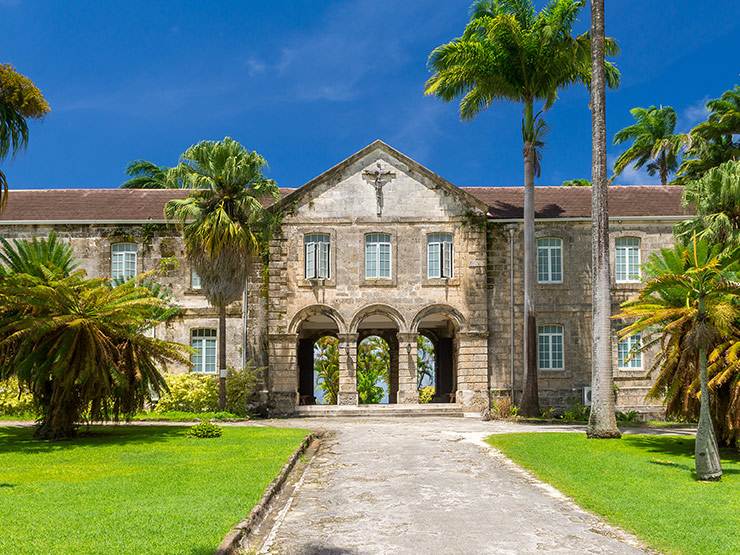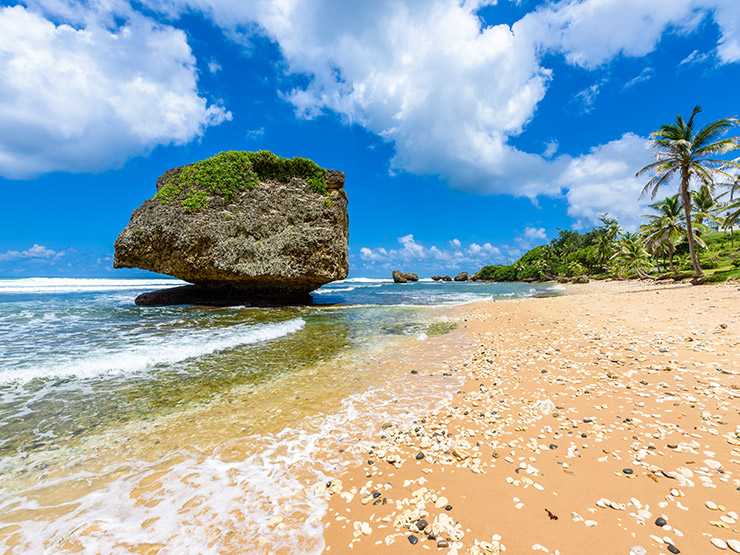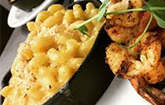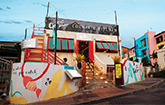|
Culpepper IslandLocated at the most easterly point of the island, Culpepper Island is a tiny uninhabited island just off the rugged coast of St. Philip in Barbados. This tiny island offers phenomenal views of the rugged east coast of Barbados.
Culpepper Island is approximately 100 feet in length, rises approximately 20 feet above sea level and is surrounded with wooded bays and limestone tunnels.
According to one account, during low tide on that eastern side of Barbados, it was possible to wade out to the island from the mainland. As Culpepper Island is located in the very turbulent Atlantic Ocean, it is highly recommended that this not become a norm as the primary reason for the erection of the East Point Lighthouse, was to save ships from these very turbulent waters.
Culpepper Island is separated from the mainland by a channel that is approximately 100ft wide.
In recent times the only real inhabitants on this island has been birds. Notably, the Atlantic Ocean has caused some erosion to the island.
False ClaimsBack in 2006 members of the region's indigenous Lokono-Arawak and Karifuna-Carib tribes have attempted to make a claim on Culpepper Island to be their own. In their claim, they stated that they were descendants of Princess Marian, daughter of the last Hereditary Lokono-Arawak Chief Amorotahe Haubariria (Flying Harpy Eagle) of the Eagle Clan Lokono-Arawaks who is buried in the Westbury Cemetery in Barbados.
Future PlansCulpepper Island is the only unspoilt offshore land that belongs to Barbados. Canadian Paul Doyle is planning a new project that will be called Anani (an Amerindian name for flower). This development is slated to take place further north, opposite Culpepper Island. This design is targeted primarily at incorporating streams and ponds that are features of the site. Each room will have its own pool and spectacular views of the oceans.
Doyle says "The east coast is hugely different. We are the rural part, where Bajans come to take their vacations. They come because of the breezes and the culture. The colour of our water is a little more turquoise, our sand a little whiter, and a little softer."
|
Your Ultimate Guide To Barbados
There are so many things to do and see here in Barbados!
View all of our best tours and start your adventure today!
Barbados Pocket Guide
Welcome to the Barbados Pocket Guide, a comprehensive source of information about our island, it's people, culture and life in general. We also have tons of information on places to stay, flights, car hire and tours of the island, all here! Enjoy visiting our site and please feel free to write a comment or send us a message directly with articles you think we need to add.
Things To Do!
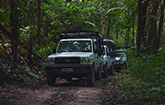
Island Safari
Island Safari offers a unique jeep safari experience on our zebra striped, specially designed 4x4 jeeps. Climb on board our comfortable cabs and let us show you what the others leave out, specifically the most scenic locations of the island by travelling on and off the beaten track.
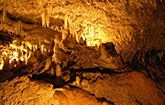
Harrison's Cave
Explore Barbados' underground! At the heart of the island lies a great geological wonder, the magnificent Harrison's Cave. Admire the crystallized, limestone cave, its flowing streams, deep pools and towering columns as you travel by tram or get up close and personal with the Eco-Adventure Tour.

Catamaran Cruise
Lay back, relax and sunbathe as you sail across the calm Caribbean Sea. Explore the crystal clear waters as you swim and snorkel with the tropical fish and majestic turtles. Then, enjoy a scrumptious lunch as you admire the beautiful rolling coastline and sparkling water.

Mount Gay Visitor Centre
Make a stop at the world renowned Mount Gay Rum Distillery and discover the secrets behind Barbados’ finest and most celebrated spirit, in the island where rum was invented! Witness the history of Mount Gay as you journey with them through their rich heritage, proven artisanship and unique taste.

SunTours Special
Grab the SunTours Special with SunTours Barbados and see all the most popular spots in Barbados! Immerse yourself in the interesting history of this island, view the most picturesque scenes and enjoy a delicious Bajan style lunch at a well favoured local spot.
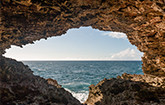
Animal Flower Cave
The colourful walls and the fascinating sea anemones at the Animal Flower Cave draw a crowd, but the amazing pools, some of which are deep enough to swim in, are the real attraction. While here, take a stroll over to the cliffs to feel the refreshing sea breeze and take in the stunning seascape.



